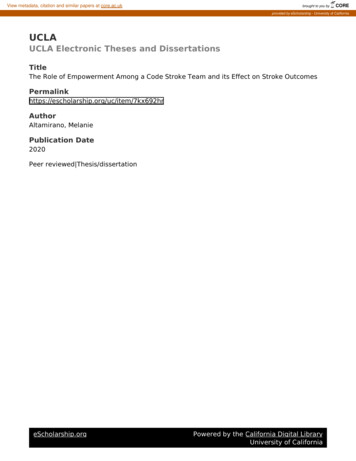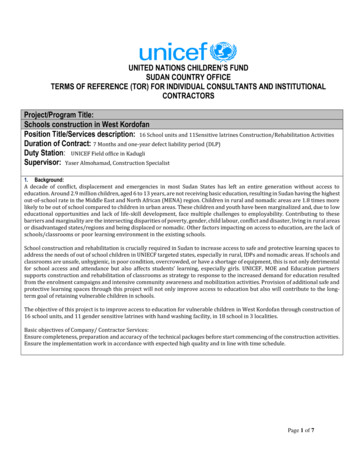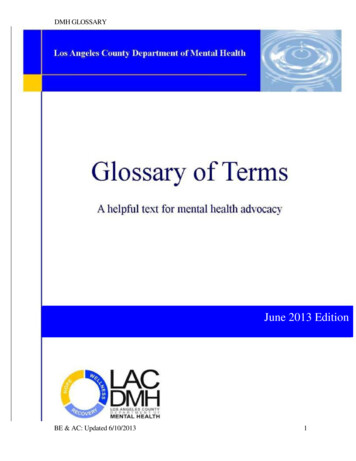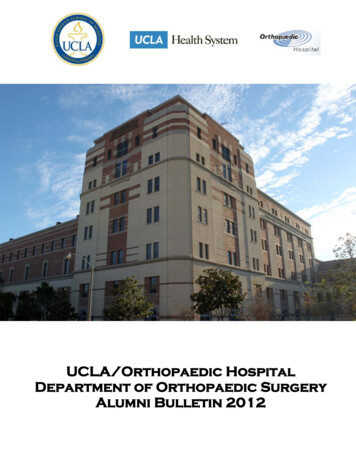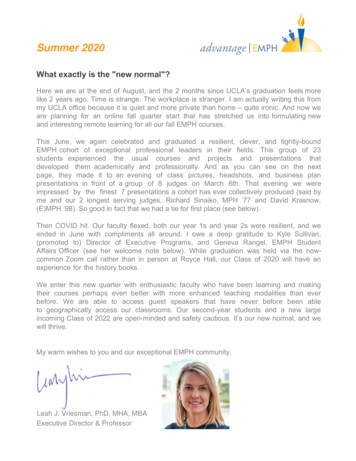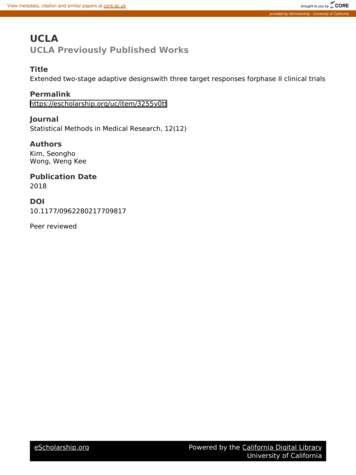
Transcription
View metadata, citation and similar papers at core.ac.ukbrought to you byCOREprovided by eScholarship - University of CaliforniaUCLAUCLA Previously Published WorksTitleExtended two-stage adaptive designswith three target responses forphase II clinical 55v0ttJournalStatistical Methods in Medical Research, 12(12)AuthorsKim, SeonghoWong, Weng KeePublication Date2018DOI10.1177/0962280217709817Peer reviewedeScholarship.orgPowered by the California Digital LibraryUniversity of California
ArticleExtended two-stage adaptive designswith three target responses forphase II clinical trialsStatistical Methods in Medical Research2018, Vol. 27(12) 3628–3642! The Author(s) 2017Article reuse guidelines:sagepub.com/journals-permissionsDOI: smmSeongho Kim1 and Weng Kee Wong2AbstractWe develop a nature-inspired stochastic population-based algorithm and call it discrete particle swarm optimization tofind extended two-stage adaptive optimal designs that allow three target response rates for the drug in a phase II trial.Our proposed designs include the celebrated Simon’s two-stage design and its extension that allows two target responserates to be specified for the drug. We show that discrete particle swarm optimization not only frequently outperformsgreedy algorithms, which are currently used to find such designs when there are only a few parameters; it is also capableof solving design problems posed here with more parameters that greedy algorithms cannot solve. In stage 1 of ourproposed designs, futility is quickly assessed and if there are sufficient responders to move to stage 2, one tests one ofthe three target response rates of the drug, subject to various user-specified testing error rates. Our designs aretherefore more flexible and interestingly, do not necessarily require larger expected sample size requirements thantwo-stage adaptive designs. Using a real adaptive trial for melanoma patients, we show our proposed design requires onehalf fewer subjects than the implemented design in the study.KeywordsAdaptive design, greedy algorithm, particle swarm optimization, power, sequential design, Simon’s two-stage design1 IntroductionPhase II clinical trials concern early exploration of efficacy effects and use the most recent results from a smallgroup of patients to make decision for the next group of patients until some prefixed termination rule is met.Group sizes can range from 20 to 120 depending on the nature and seriousness of the disease. Kramar et al.1provides a review on multistage designs for phase II clinical trials and statistical issues in cancer research andBrown et al.2 gives an overview of the role of phase II trials in oncology. Increasingly, these designs employ anadaptive approach, where design decisions for the next stage are made based on cumulative responses. Chow andChang3 reviews adaptive randomization designs in clinical trials.Simon’s two-stage design was developed under a framework that if the proportion of responders in stage 1 issmall, the trial is terminated; otherwise, the trial goes on to stage 2 where the cumulative response rate is now usedto test whether the efficacy rate is at a higher pre-specified level. In essence, two user-selected efficacy rates areposited p0 and p1 with p0 5 p1 , and p0 is the uninspiring response rate. In stage 1, we test the null hypothesisH0 : p ¼ p0 and if we fail to reject the null hypothesis, we terminate the trial; otherwise, we conclude that the drugis sufficiently promising to advance to stage 2, where more responses from more patients will be used to test p ¼ p1.Given pre-specified Type I and II error rates for the tests at the two stages, the design questions are the number ofpatients required in stage 1, number of responders required in stage 1, how many additional patients are requiredfor stage 2 and the cumulative number of responders required at the end of stage 2. The design problem is todetermine the optimal combination of these four numbers, so that the expected number of patients treated with a12Biostatistics Core, Karmanos Cancer Institute, USADepartment of Biostatistics, UCLA School of Public Health, USACorresponding author:Seongho Kim, Biostatistics Core, Karmanos Cancer Institute School of Medicine, Wayne State University, Detroit, MI, USA.Emails: kimse@karmanos.org; wkwong@ucla.edu
Kim and Wong3629drug of low activity under the null hypothesis is minimized. Such an optimal design may not be unique and otherdesign criteria are possible.Lin and Shih4 provided practical examples and showed that while it was relatively easy to specify theuninteresting rate p0, the same was not true for p1. To tackle the issue of uncertainty in targeting thehypothesis in stage 2, they proposed designs that allowed two specifications for p1 and called one a skepticalchoice and the other the optimistic choice. Their design problem now has seven parameters to optimize in contrastto four in Simon’s two-stage design, subject to user-specified Type I and II error constraints. The additional threeparameters beyond the four parameters required for Simon’s two-stage design are for testing the additionaltargeted efficacy rate. Both Simon and Lin and Shih employed a greedy search to find the optimal designs andthe latter stated that they ‘‘did not extend the selection to more than two prefixed possible response rates mainlydue to the complexity in the numerical solutions, and also because it is usually adequate for practitioners tocontemplate between two (high/low) choices of the response rate p1.’’Our work was motivated by a real problem from clients interested to conduct a single-arm two-stage phase IItrial to the effect of head and neck cancer (HNC) on the incidence of obstructive sleep apnea (OSA). Our clients’main goal was to ascertain accurately the incidence rate of OSA on HNC patients in a timely manner. Because ofthe potential huge beneficial impact on treating HNC patients, the clients wanted a relatively simple designthat could terminate the study at stage 1 if the initial response (OSA incidence) rate was poor; otherwise, stage2 of the design used the number of responders, who experienced OSA from stage 1 to recruit more patients tomore accurately assess the incidence rate of OSA. Clearly, Simon’s5 two-stage design proposed in 1989 andthe adaptive two-stage design proposed by Lin and Shih4 seemed useful.Our clients were particularly interested to extend Lin and Shih’s4 approach to include an additional targetedalternative hypothesis for testing in the second stage. The main reason was the great uncertainty in the OSAincidence rate on HNC patients and the need to move a potentially promising impact further in the treatment ofHNC patients expeditiously with a very good estimate of the true OSA incidence rate of HNC patients.Thus depending on the number of responders, who experience OSA in stage 1, more flexibility in specifying theincidence rate of OSA in stage 2 is required. In particular, the clients did not want to run another costly follow-uptrial to more accurately evaluate the incidence rate of OSA in HNC patients. Another motivation for having such adesign was also recently made aware to the second author by personal communication from a senior researcher atthe National Institutes of Health. She mentioned that in oncology, there is a great tendency for researchers to betoo optimistic on the efficacy rate of a new drug. Our proposed designs should help address such an issue byallowing the clinician the flexibility to perform a test at stage 2 for one of the two lower efficacy rates should thedrug efficacy rate be over-specified in the first place. In what is to follow, we discuss and construct extended twostage adaptive designs for our OSA study and two other applications. The first one is Lin and Shih’s4 vinorelbine,bleomycin, and gemcitabine (VBG) study for patients with recurrent or refractory Hodgkin’s disease (HD) and thesecond one is a Phase II BREAK-2 study for melanoma patientsWe were able to formulate the optimization problem quickly as an extension of that from Lin and Shih’s4article, but anticipated the optimization burden for the new constrained optimization problem now with10 parameters to optimize for the three user-selected targeted alternative hypotheses in stage 2 and subject tovarious user-specified Type I and II error rate constraints. Lin and Shih4 acknowledged computational difficultiesin their work at that time and remarked that further extension of the problem would seem to be a too challengingor an impossible computational task. In what is to follow, we present an algorithm to solve this complexconstrained optimization problem and show that our extended two-stage adaptive design has advantages overboth Simon’s two-stage design and Lin and Shih’s designs in a number of ways.There are many variations of strategies proposed for phase II designs since Simon’s two-stage design wasproposed. We mention some here and refer to earlier cited articles for a comprehensive overview.Modifications and extensions of the likes of Simon’s two-stage design include having two binary outcomes6 orfinding designs that minimize the expected sample size or minimize the expected maximum sample size, not underthe null hypothesis but under the alternative hypothesis. For example, Mander and Thompson7 and Mander et al.8investigated novel designs, which are optimal under the alternative hypothesis, that the tumor response rate ishigher than the null hypothesis value, and also designs which allow early stopping for efficacy. Wason et al.9considered reducing sample size for phase II trials with a continuous outcome, and Kwak and Jung10 proposed atwo-stage adaptive optimal design for single arm trials with right-censored survival time that minimizes theexpected sample size subject to Type I and II error rate specifications. Phase II designs with three stageswere motivated and proposed in literature.11–13 Schlesselman and Reis14 noted limits and benefits of phase IItrials and Zhou15 gave some guidance on the choice of a design for an early phase trial.
3630Statistical Methods in Medical Research 27(12)Software for computing various types of phase II adaptive designs for such trials is available in commercialsoftware statistical packages, like SAS, STATA, and JMP. They are also codes on webpages that generate variousadaptive optimal designs for early phase trials after the error rates are specified. One such site is at m. Because none of the current software can find our proposed designs, we havedeveloped codes to run on a web browser using the R package shiny (http://shiny.rstudio.com) to generate ourproposed designs. We call our R package ss2stagePSO and it is freely available at http://cansur.wayne.edu/.We also provide an option to compare competitive designs and user-specified designs relative to the optimaldesigns by reporting their relative efficiencies.In the next section, we first describe extended two-stage adaptive designs for phase II clinical trials and technicalbackground before discussing nature-inspired stochastic population-based algorithms for finding our proposeddesigns. There are many of them and, as an example, we focus on particle swarm optimization (PSO), which seemto be widely used. Motivated from our recent successes with this flexible algorithm, we modified it for ourapplication at hand, because PSO was originally designed to solve optimization problems over a continuousdomain, not optimization over a domain comprising of discrete positive integer numbers, and call it discreteparticle swarm optimization (DPSO). In particular, we show how DPSO solves our extended two-stageadaptive design problems and related problems effectively that a greedy algorithm cannot. We then apply ouralgorithm to real applications and show our proposed designs require smaller sample sizes than those that wereimplemented in the trial. The article is concluded with a summary2 Extended two-stage adaptive designsSuppose p0 is the maximum uninteresting response rate and there are three choices for the target response rates:p1 , p2 , p3 , where 0 5 p0 5 p1 5 p2 5 p3 5 1. Data from stages 1 and 2 will be used to test one of the null hypothesesin stage 2 depending on the number of responders in stage 1. Our adaptive design assumes that a total of n1 patientsare assigned at the first stage and the total number of patients and tests required in the entire trial will depend on thenumber of responses in the first and subsequent stages. The null hypothesis at the first stage is H0: p p0 . Accordingto the number of responses in the first stage, the corresponding alternative hypothesis will be one of three hypotheses:H11: p 4 p1 , H12: p 4 p2 and H13: p 4 p3 . Using similar notation in Lin and Shih,4 our extended two-stage adaptivedesign has a total of 10 parameters given by ¼ ðs1 , r1 , q1 , n1 , s, l, r, m, q, nÞ and it operates as follows:. Step I: Begin by recruiting n1 patients in the first stage of our design and observe the number of the responses, x,from of n1 patients. Step II:(1) If x s1 , stop the trial with failure to reject H0 (i.e. p p0 )(2) If s1 5 x r1 , power the study at (1- 1) for p ¼ p1 and enter l2 ¼ l n1 additional patients into the study.Reject the hypothesis that H11: p 4 p1 if the total number of responses s out of l patients.(3) If r1 5 x q1 , power the study at (1- 2) for p ¼ p2 and enter m2 ¼ m n1 additional patients into thestudy. Reject the hypothesis that H12: p 4 p2 if the total number of responses r out of m patients.(4) If x 4 q1 , power the study at (1- 3) for p ¼ p3 and enter n2 ¼ n n1 additional patients into the study.Reject the hypothesis that H13: p 4 p3 if the total number of responses q out of n patients.By construction, the values of l, m, n are the total number of patients required for the entire trial correspondingto the alternative hypotheses, H11: p 4 p1 , H12: p 4 p2 , and H13: p 4 p3 , respectively. The extended two-stageadaptive design has a total of 10 parameters denoted by ¼ ðs1 , r1 , q1 , n1 , s, l, r, m, q, nÞ that we wish tooptimize given error rate constraints and the stipulated three response rates. If the true response probability isp, the probability of failing to reject H0 is given byGð j pÞ ¼ Bðs1 , n1 , pÞ þminðrX1 ,sÞbðx, n1 , pÞBðs x, l2 , pÞx¼s1 þ1þminðqX1 ,rÞx¼r1 þ1bðx, n1 , pÞBðr x, m2 , pÞ þminðq,nX 1Þð1Þbðx, n1 , pÞBðq x, n2 , pÞx¼q1 þ1where b and B are the probability density function and cumulative density function of a binomial distribution,respectively, with l ¼ n1 þ l2 , m ¼ n1 þ m2 , and n ¼ n1 þ n2 . It follows that when the true probability response rate
Kim and Wong3631is p, the expected sample size isEðNj p, Þ ¼ n1 þ ðBðr1 , n1 , pÞ Bðs1 , n1 , pÞÞl2þ ðBðq1 , n1 , pÞ Bðr1 , n1 , pÞÞm2 þ ð1 Bðq1 , n1 , pÞÞn2ð2Þ the set containing all values of that satisfies four naturalOur design problem is to find a good choice 2 ,error constraintsGð j p0 Þ 1 , Gð j p1 Þ 1 , Gð j p2 Þ 2 and Gð j p3 Þ 3ð3ÞThe goodness of may be determined by one of the following four optimality criteria:.C1:C2:C3:C4: ¼ arg min 2 EðNj p0 , Þ; ¼ arg min 2 EðNj p0 , Þ and ¼ arg min 2 fmaxðl, m, nÞg; ¼ arg min 2 fmaxi¼0,1,2,3 EðNj pi , Þg; ¼ arg min 2 fmaxi¼0,1,2,3 EðNj pi , Þg and ¼ arg min 2 fmaxðl, m, nÞg.The optimality criteria C1–C4 are extensions of Lin and Shih’s4 criteria and, if there is only one target response,criteria C1 and C2 are exactly the same as Simon’s two optimality criteria. Our proposed extended two-stageadaptive design is schematically described in Figure 1.The above extension to three prefixed possible target responses may appear straightforward to implement, butin reality, it is computationally impractical to find a solution by the use of greedy algorithms due to its complexity.Indeed, we formulate the optimization problem and show that greedy algorithms fail to find a solution for our10-dimensional optimization problem after running it for 30 days. To this end, we briefly review a nature-inspiredFigure 1. Flowchart of the extended two-stage adaptive design for Phase II clinical trials (third column) with s1 5 r1 5 q1 . Simon’stwo-stage design is obtained by setting r1 ¼ n1 (first column) and Lin and Shih’s design is obtained by setting q1 ¼ n1 (second column).
3632Statistical Methods in Medical Research 27(12)stochastic population-based algorithm, PSO technique, and show that it not only provides solutions in a relativelyshort time but also facilitates performance comparison among different algorithms in the following sections.3 DPSOPSO, a population-based global optimization method, was introduced by Kennedy and Eberhart.16 It is anevolutionary algorithm and stochastically evolves a group of particles that mimic observational behavior fromnature. PSO is motivated from observing how a flock of birds move in the sky and so is a member of the class ofnature-inspired stochastic population-based algorithms. This class of algorithms has been gaining lots ofrecognition especially in the last decade or so for its ability to solve or nearly solve hard-to-optimize highdimensional problems in the real world. Whitacre17,18 documented the meteoric rise in use of such algorithmsin applied fields and increasingly in academia as well. Their main appeals are that they are simple to implement,assumption-free and tend to quickly converge to the optimum or get quickly to the vicinity of the optimumsolution. Additionally, they are general-purpose optimization algorithms and so are adaptable to solve differenttypes of optimization problems after the user inputs some tuning parameters to initiate the algorithm. Geneticalgorithm, simulated annealing, and PSO are examples of such algorithms.Some recent applications of PSO to solve optimal design problems in statistics are in literature.19–22,23 Theytackled design problems in biomedical problems that ranged from finding D-optimal designs for several nonlinearmodels and mixture models with multiple constraints to finding minimax and standardized maximin type ofoptimal designs. The latter designs have non-differentiable optimality criteria that require a couple of nestedlevels of optimization and are notoriously difficult to find. Phoa et al.21 applied swarm intelligence to find anoptimal supersaturated design in a high dimension problem that involves judicious and repeated exchanges ofcolumns in the design matrix to minimize correlations among the columns via the Eðs2 Þ criterion. PSO has alsosuccessfully used for estimation in statistical problems. For example, Kim and Li24,25 applied PSO to estimateparameters in nonlinear mixed-effects pharmacokinetics models, and Kim et al.26 employed PSO to estimateefficacy of different lung cancer screening methods. In each of the above problems, we observed, as manyothers had, the flexibility of PSO and how it can be readily modified to solve an optimization problem at hand.In what is to follow, we first demonstrate yet again that PSO can be adapted to efficiently solve our adaptive designproblem with a very different setup than those just mentioned above. Second, we show PSO can solve highdimensional problems with many parameters in our adaptive design problems that current greedy algorithmscannot and third, PSO can substantially outperform greedy algorithms in adaptive design problems with a smallnumber of parameters.Operationally, the user initiates PSO by first specifying the maximum of iterations allowed, say K and the flocksize consisting of, say N, randomly generated particles for the search. Each particle represents a candidate solutionto the problem and at any one time, each has a fitness value (i.e. the design criterion value). As it searches, it keepstrack of its best value (personal or local best value) and communicates with the rest of the particles to determinethe global best value, defined as the best personal best value among the flock up to that iteration. The particlesupdates these two values continuously as it moves across the search space in the direction guided by its most recentlocal best and the global best with a velocity determined stochastically by a combination of values of the tuningparameters, its personal best and the global best and the velocity with which it has arrived at the current position.Specifically, suppose the nth particle’s position vector is xn ¼ ðxnk Þ0k¼1, ., K and its updating velocity vector isvn ¼ ðvnk Þ0k¼1, ., K , n ¼ 1, . . ., N. If its local best and global best are xnlbest and xgbest, respectively, its velocity vnkþ1and the position xnkþ1 at the ðk þ 1Þth iteration are determined byvnkþ1 ¼ wk vnk þ c1 r1 ðxnlbest xnk Þ þ c2 r2 ðxgbest xnk Þ;xnkþ1 ¼ xnk þ vnkþ1ð4ÞHere wk is the inertia weight (0 wk 1) at the kth iteration, c1 and c2 are two positive constants calledcognitive and social coefficient, and r1 and r2 are two random variates in the range [0, 1]. The lower limitvalues of the constants c1 and c2 determine how far particles are allowed to wander beyond the target regionbefore pulled back, and their upper limit values determine how sudden the particles should be moved back to thetarget region. Following convention, we set c1 and c2 to their default values equal to 2 in our simulation studies. Atthe kth iteration, the inertia weight wk is wk ¼ wmax -Kk ðwmax wmin Þ, where wmin and wmax are user-definedconstants satisfying 0 wK ¼ wmin wk wmax ¼ w0 1.During the search, the inertia weight adaptively controls the impact of the previous history of velocities on thecurrent velocity and also influences the trade-off between global (wide-ranging) and local (nearby) exploration
Kim and Wong3633abilities of the particles, as they move across the search space. A larger inertia weight facilitates global exploration(searching new areas) and a smaller inertia weight facilitates local exploration. When the inertia weight is suitablychosen, it can provide a balance between global and local exploration abilities and on average, require feweriterations to find the global optimum.27 To exploit these properties of the inertia weight, we use a dynamic inertiaweight to enable PSO escape from premature convergence when it is stagnated.28PSO was originally designed to solve optimization problems over a continuous domain, not optimization over adomain comprising of discrete positive integer numbers. Since PSO is a flexible algorithm, we modified it for ourproblem and call it DPSO. The task is to choose the right combination of several positive integers that wouldminimize the total sample size required under various hypothesis and, at the same time, meet the user-specifiedType I and II error rates. The proposed DPSO has two different features fromPSO:weight w0k is the (a) the inertia 01knearest integer of PSO’s inertia weight wk at the kth iteration, i.e. wk ¼ wk þ 2 ¼ wmax K ðwmax wmin Þ þ 12 ,where bxc ¼ arg maxm fm 2 Zjm xg and Z is a set of integers, and (b) the two random sequences are generatedfrom a discrete uniform distribution.3.1Extended two-stage adaptive design with three target responses the optimal value for ¼ ðs1 , r1 , q1 , n1 , s, l, r, m, q, nÞ forWe consider two optimization approaches to find ,our adaptive design problem. One is the greedy search and the other is DPSO proposed in this study. The greedysearch adopts the strategies used in Simon’s or Lin and Shih’s4 algorithms for the extended two-stage adaptivedesign. Specifically, we first calculate the required sample sizes ni, i ¼ l, m, and n, for a single-stage design, where nl,nm, and nn are the required sample sizes corresponding to the target response rates p1, p2, and p3, respectively, andconstrain l, m, and n to be in the range of b0:85 ni c i b1:5 ni þ 1c, where i ¼ l, m, and n. For each value of l,m, and n, and each of n1 in [1,minðl, m, nÞ 1], s1 in [0, n1], r1 in [s1 þ 1, n1], and q1 in [r1 þ 1, n1], we then find the that satisfies the error constraints (3) for q in [q1 þ 1, n], r in [r1 þ 1, m], and s in [s1 þ 1, l]set of feasible solutions and determine the optimum according to one of optimality criteria C1–C4.To implement DPSO, we specify the lower and upper boundaries for each component of the parameter vector ¼ ðs1 , r1 , q1 , n1 , s, l, r, m, q, nÞ. Similar to the greedy search, we use the sample sizes nl, nm, and nn, requiredfor a single-stage design corresponding to the target response rates p1, p2, and p3, respectively and setLi ¼ b0:85 ni c, i ¼ l, m, n;Ui ¼ b1:5 ni þ 1c, i ¼ l, m, n;ð5ÞU ¼ minfUi ; i ¼ l, m, ng:The lower and upper boundaries for each component of are then obtained as follows: Umþ 1 ; r1 2 0, U p1 þ 1 ; q1 2 0, U p2 þ 1 ; n1 2 ½1, U ;s1 2 0,2 s 2 0, Ul p1 þ 1 ; l 2 ½Ll , Ul ; r 2 0, Um p2 þ 1 ; m 2 ½Lm , Um ; q 2 0, Un p3 þ 1 ; n 2 ½Ln , Un ,and used in DPSO to find the optimal solution under each of the C1–C4 optimality criteria among the feasible that satisfy the error constraints (3).solutions in The standard PSO is usually not sensitive to the initial values of the tuning parameters and can find an optimalsolution using the default values. However, in our DPSO, a lot of iterations is required for convergence, especially Forwhen there are two or three target responses and the initial values were not among the feasible solutions in .this reason, we consider two approaches (G-DPSO and D-DPSO) to find an appropriate initial set of values to boost the speed of convergence of DPSO.among the feasible solutions in In the first approach, the initial value is found by a greedy search over a smaller range of values for ni and notover the entire range, where i ¼ l, m, and n. Specifically, the required sample sizes ni, i ¼ l, m, and n, are in the rangeof ni 1 i ni þ 1, where i ¼ l, m, and n. Within this smaller domain, we searched for an appropriate set ofinitial values using the same strategy as the greedy search did for the rest of the parameters. By shrinking the rangeof the parameters ni, i ¼ l, m, and n, we potentially reduced the computational burden. We call DPSO with this firstapproach G-DPSO. In particular, we observed the consistency of the computation time with a short amount oftime, when G-DPSO was applied to the case with one target response (see Table 1 and Supplementary InformationTable S1). However, similar to the greedy search, the computation time of G-DPSO increases as the number of
3634Statistical Methods in Medical Research 27(12)Table 1. Various adaptive two-stage optimal designs with one target response when ¼ 0.05 and ¼ C2C3C40.550.70C1C2C3C4Methods1 n1s/n1 EðNj p0 ÞEðNj p1 3569.73564.66264.66264.66264.66264.66264.662a,b: The number of particles was increased from 10 to 20 and the population size was increased from10,000 to 70,000.target response s increases, especially for two or three target responses (for example, see Tables 2 and 3 andSupplementary Information Tables S2 and S3). Therefore, we devise the second approach that does not depend onthe number of target responses for the cases with two or three target responses.The second approach abbreviated as D-DPSO is used when the number of target responses is two or more. DDPSO finds the initial set of values using an optimal set of values decided by the case with the one less number oftarget response. In other words, when the number of target responses is k, the initial value is decided using thesample sizes determined by the case when the number of target responses is k 1, where k ¼ 2, 3. By doing so, wecould make the second approach not depend on the number of target responses in terms of computation time. Thespecific details for implementing D-DPSO to search for any one of the four types of optimal design when there aretwo and three target responses are as follows.3.1.1 The number of target responses is twoWe first obtain two sets of sample sizes, E1 ¼ s11 , n11 , s1 , n1 and E2 ¼ s21 , n21 , s2 , n2 , from the target responses p1and p2, respectively, based on the G-DPSO method when there is one target response. Then, using the two sets of r , n ¼ rank3 s11 , n11 , s21 , n21 , s1 , n1 , s2 , n2 , wheresample sizes E1 and E2, the initial value is set to 2 ¼ s 1 , r 1 , m 1 , s , m,rankk S is the top k elements of the set S arranged in ascending order. The first three values ( s1 , r 1 , m 1 ) correspondto the null response p0 (i.e. the first stage), so the sample sizes s11 , n11 , s21 , n21 , which correspond to the first stage of and ( r, n) correspond to the target values p1 and p2 (i.e. the second stage),E1 and E2, are used. Since ( s, m)respectively, the values (s1, n1) and (s2, n2), which correspond to the second stage of E1 and E2, are used.3.1.2 The number of target responses is threeWe first obtain two sets of sample sizes E1 ¼ s11 , r11 , m11 , s1 , m1 , r1 , n1 and E2 ¼ s21 , n21 , s2 , n2 using the D-DPSOwith the target responses (p1, p2) and the G-DPSO with the target response p3, respectively. Then, the initial value
Kim and Wong36
2Department of Biostatistics, UCLA School of Public Health, USA Corresponding author: Seongho Kim, Biostatistics Core, Karmanos Cancer Institute School of Medicine, Wayne State University, Detroit, MI, USA. Emails: kimse@karmanos.org; wkwong@ucla.edu Statistical Methods in Medical Research 2018, Vol. 27(12) 3628-3642! The Author(s) 2017





